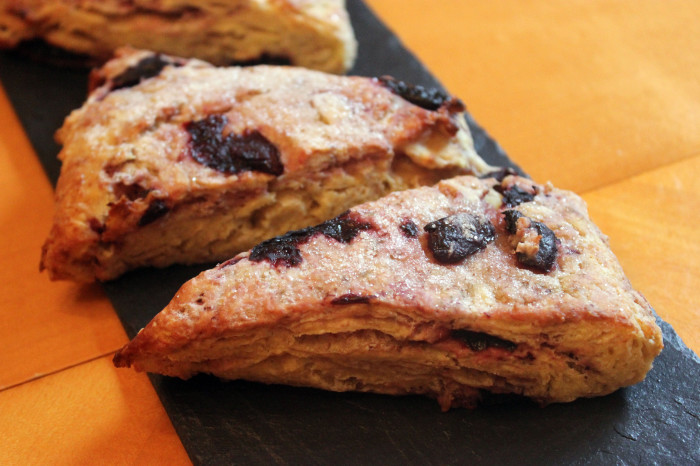This is an unusual post. I’m comparing two scone recipes, one old and one new. Suzen and I have made both, tasted both, and must say we have a favorite: the new one. In the comparison that follows, you’ll why the new one is so different and you’ll get an idea of how widely the ingredients in a “standard” recipe can vary.
From 30 Years at Ballymaloe, Darina Allen shares these Sweet White Scones that her mother prepared decades ago. In comparison, we have a recipe for Crème Fraiche Scones from Sweet by Valerie Gordon. As you’ll see in the table below comparing the ingredients, Valerie uses far more butter, baking powder, and sugar relative to the amount of flour being used. Darina uses 7 ¼ cups of flour with ¼ cup of sugar, while Valerie has only two cups of flour but ⅓ cup sugar. On a relative basis, Valerie’s recipe has 5 times more sugar than Darina’s.
And the consequence? Valerie’s scone is distinctly sweet, lusciously soft. Darina’s has, to my palette, a flat flavor, but a more interesting texture. With both less sugar and butter to melt and bond the flour, in Darina’s you actually get some layering and separation, as if the scone were made of a faux puff pastry. Darina’s scone is not a uniform biscuit, which is what Valerie’s is much more like.
Darina’s version is, in fact, perhaps much more authentic. If you remember your first scone taste a couple of decades ago, you may not have fallen in love. I used to think of scones as stones. Scones were a food for people of modest means. They did not, as does Valerie, has some crème fraiche to throw in, and sugar was costly. Today, we have developed preferences that tend toward softer textures and sweeter flavor.
So, why am I presenting Darina’s recipe to you if it is not my favorite. Partly for contrast and history. Partly to give you something to experiment with. If you have only eaten scones that taste like biscuits shaped into a triangle, then Darina’s is something to try. And, by the way, if you add a little butter and some jam, Darina’s scone is lovely and that different texture is something to sense. As I keep saying: not a biscuit.
In the picture you see, we’ve added some cherries, cut into quarters. Darina’s book has a dozen ideas for adding flavor to the scones: raisin, rosemary, crystallized ginger, candied citrus peel, sugar and spice, poppy seed, chocolate chip, or white chocolate. Take a look at Darina’s book and experiment. You’ll be starting with an authentic, heritage recipe.
[And, clearly, you can add a little sugar or butter!]
Mother’s Sweet White Scones
Yield: 18-20 scones if cut into circles
Ingredients:
| Item | Sweet White Scones | Crème Fraiche Scones |
| Yield | 18-20 | 12 |
| Flour | 7 ¼ cups | 2 cups |
| Salt | Pinch | ½ teaspoon |
| Sugar | ¼ cup | 1/3 cup |
| Baking Powder | 3 heaping teaspoons | 2 teaspoons |
| Butter | 12 tablespoons | 5 tablespoons |
| Eggs | 3 | 2 large |
| Dairy | 2 cups milk | 1 cup crème fraiche |
| Other | Egg wash made of 1 egg whisked with a pinch of salt, plus sugar for topping off | 1 tablespoon grated lemon zest + 1 tablespoon fresh lemon juice |
Preparation:
Preheat the oven to 475°F. Sift all the dry ingredients into a large, wide bowl. Cut the butter into cubes, toss in the flour, and rub in with your fingertips until the mixture resembles very coarse bread crumbs—surprisingly, this results in lighter scones.
Make a well in the center. Whisk the eggs with the milk in a pitcher. Add to the dry ingredients and mix to a soft dough. Turn onto a floured board. Don’t knead but shape just enough to make a round. Roll out to 1 inch thick and cut or stamp into scones. Stamp out the scones with as little waste as possible; the first scones will be lighter than the second rolling. If you cut them into squares or triangles with a knife or pastry cutter, as my mother did, there is no need to roll again.
Transfer the scones to a baking sheet—there is no need to grease it. Brush the tops with the egg wash and dip each one in granulated sugar. Bake in the hot oven for 10-12 minutes, until golden brown on top. Transfer to a wire rack to cool.
Serve split in half with homemade jam and a dollop of whipped cream, or with just butter and jam.
Source: 30 Years at Ballymaloe by Darina Allen
Photo Information [top picture]: Canon T2i, EFS 60 mm Macro Lens, F/5.0 for 1/60th second at ISO-2500

